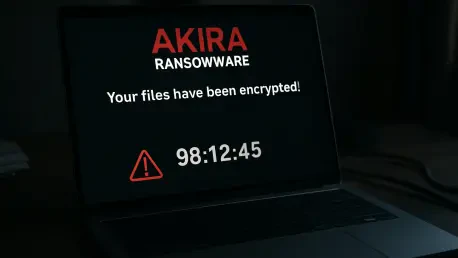What happens when a trusted shield becomes the very gateway for chaos? In the realm of cybersecurity, SonicWall SSL VPN appliances, long relied upon for secure remote access, have turned into prime targets for a ruthless adversary: the Akira ransomware group. Since late July, these devices have been bombarded by attacks exploiting a known flaw with surgical precision, leaving organizations scrambling to defend against rapid intrusions. This escalating threat paints a stark picture of a digital battlefield where even patched systems are not safe from credential theft and lightning-fast breaches.
Why SonicWall SSL VPNs Are Caught in the Crosshairs
SonicWall SSL VPNs have become a focal point for cyber attackers due to their widespread adoption across industries. These appliances serve as critical entry points for remote workers, making them high-value targets for ransomware groups like Akira. The exploitation of CVE-2024-40766, an improper access control vulnerability, has allowed attackers to harvest credentials and infiltrate systems, even after patches were applied, exposing a dangerous gap in post-patch security.
The significance of this campaign lies in its scale and speed, challenging the very foundation of secure access protocols. With ransomware attacks costing businesses billions annually, the targeting of SonicWall devices underscores a broader trend: adversaries are zeroing in on infrastructure that organizations depend on most. This situation demands urgent attention, as the narrow window for response—often just hours—amplifies the risk of catastrophic data loss and operational disruption.
The Akira Ransomware Menace: A Growing Shadow
Akira ransomware has swiftly risen as a dominant force in the cybercrime landscape, exploiting vulnerabilities with chilling efficiency. Unlike traditional ransomware groups, Akira’s tactics focus on critical systems like VPNs to maximize impact. Their latest campaign against SonicWall appliances highlights a disturbing evolution in ransomware strategies, where speed and sophistication converge to outpace conventional defenses.
The urgency of this threat is evident in the attackers’ ability to operate within a drastically short dwell time. Arctic Wolf’s findings reveal that once inside, Akira actors initiate internal scanning and reconnaissance within minutes, leaving defenders little room to react. This rapid escalation signals a shift toward more aggressive and coordinated ransomware operations, posing a severe challenge to global cybersecurity efforts.
Unpacking the Attack: A Blueprint of Precision and Pace
The Akira campaign against SonicWall SSL VPNs reveals a multifaceted attack strategy designed for maximum disruption. Attackers exploit CVE-2024-40766 to gain initial access through credential harvesting, bypassing security even on updated systems. Within five minutes of login, internal network scanning begins, followed by Active Directory reconnaissance, showcasing an alarming pace that shrinks dwell time to mere hours.
Further sophistication emerges in their use of automated tools, with scripted logins traced to hosting provider IPs indicating a high level of coordination. Techniques like Bring-Your-Own-Vulnerable-Driver (BYOVD) are deployed to evade detection by security software, while the potential bypass of one-time password (OTP) multi-factor authentication (MFA)—possibly through stolen OTP seeds—adds another layer of concern. These methods, detailed in Arctic Wolf’s analysis, illustrate an adversary that operates with both speed and stealth.
Voices from the Trenches: Expert Warnings and Hard Truths
Insights from cybersecurity experts paint a grim picture of the Akira threat. Arctic Wolf’s report emphasizes the unprecedented velocity of these attacks, noting, “The short dwell time of hours, not days, leaves organizations with almost no margin for error in detection and response.” This stark observation underlines the critical need for real-time vigilance against such fast-moving adversaries.
Adding to the concern, Google Threat Intelligence Group has raised the possibility of OTP seed theft as a method for bypassing MFA, a tactic that could undermine one of the most trusted security measures. Combined with reports of repeated malicious logins from single IP addresses with no prior suspicious activity, these expert perspectives highlight an evolving ransomware landscape that continuously adapts to challenge even the strongest defenses.
Fortifying Defenses: Practical Steps for SonicWall Users
For organizations relying on SonicWall SSL VPNs, proactive measures are essential to counter the Akira threat. Real-time monitoring of VPN logins should focus on connections from hosting-related Autonomous System Numbers (ASNs) as potential early warning signs. Additionally, tracking SMB session setup requests tied to Impacket activity can help identify discovery behaviors indicative of an ongoing attack.
Beyond monitoring, restricting access is a critical safeguard. Blocking logins from virtual private server (VPS) hosting providers, anonymization services, and irrelevant geographic regions can significantly reduce the attack surface. Enhanced scrutiny of MFA configurations, coupled with vigilance for unusual OTP activity, is also vital to detect potential seed theft. While patching remains crucial, the reality of post-patch credential theft demands a multilayered approach to security that anticipates and mitigates risks before they escalate.
Reflecting on a Relentless Battle
Looking back, the siege on SonicWall SSL VPNs by Akira ransomware actors exposed a harsh reality: even trusted security tools could become liabilities when targeted by determined adversaries. The campaign’s rapid execution and sophisticated evasion tactics served as a wake-up call for organizations worldwide, revealing the limitations of traditional defenses against modern threats. Each breach underscored the fragility of digital perimeters in the face of evolving cybercrime.
Moving forward, the lessons learned demanded immediate action through enhanced monitoring, stricter access controls, and a deeper understanding of attacker methodologies. Strengthening authentication mechanisms, particularly around MFA, emerged as a priority to close gaps exploited by stolen credentials. As the cybersecurity landscape continued to shift, the focus turned toward building adaptive, resilient systems capable of withstanding the next wave of attacks, ensuring that past vulnerabilities did not dictate future outcomes.









